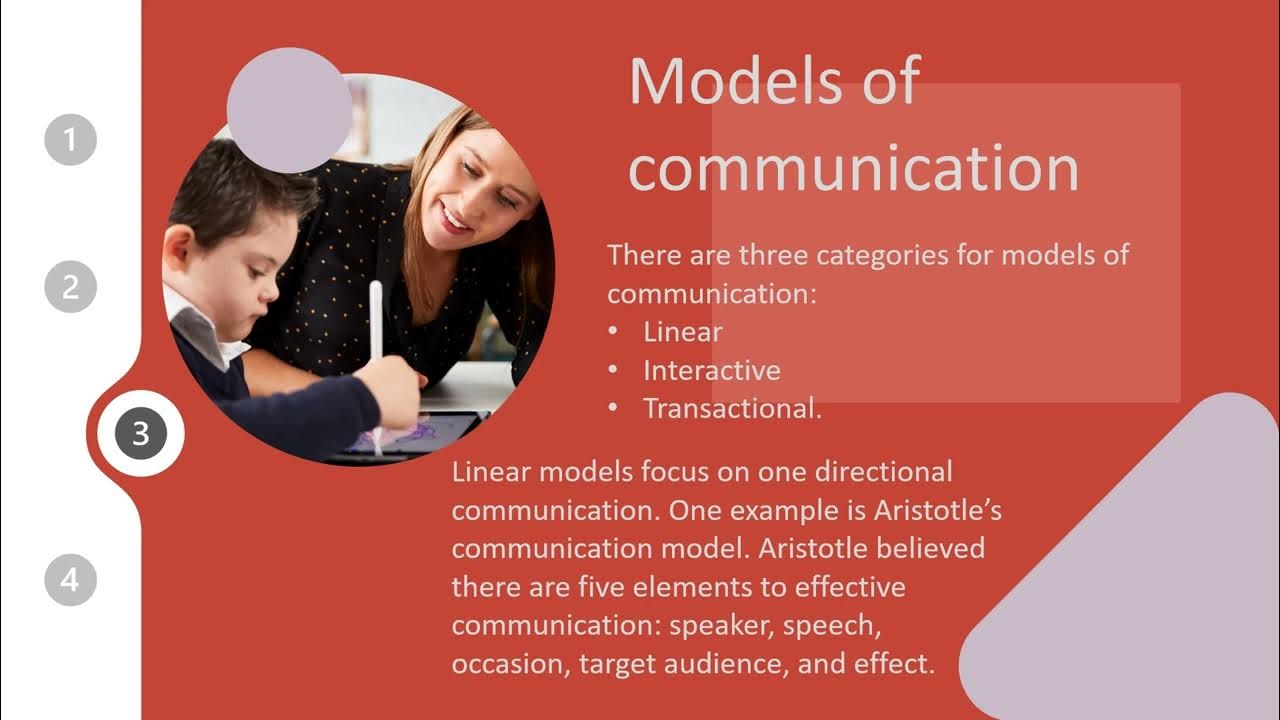The Nature of Communication
Summary
TLDRThe video script delves into the intricacies of communication, highlighting its two-way nature where both sender and receiver actively participate. It underscores the contextual aspect, emphasizing how meaning shifts with setting and cultural nuances. The script also points out the importance of non-verbal cues, which can be as significant as verbal messages. It categorizes communication into verbal, non-verbal, and visual, each with unique strengths and weaknesses. Effective communication is often a blend of these types, and the script suggests being clear, concise, and adaptable to enhance communication and build stronger relationships.
Takeaways
- 🗣️ Communication is a two-way process involving active participation from both the sender and the receiver.
- 🔁 Feedback is essential for ensuring that messages are understood and that communication is effective.
- 🌐 The meaning of a message is contextual and can vary based on factors like relationship, setting, and cultural background.
- 👁️🗨️ Non-verbal cues such as tone of voice, facial expressions, and body language are crucial in conveying meaning.
- 💬 Verbal communication is efficient for complex information but can be challenging to interpret.
- 🤔 Non-verbal communication is effective for conveying emotions and building connections but can be hard to control.
- 🎨 Visual communication is eye-catching and memorable but may struggle with complex information.
- 🤝 The most effective communication often combines different types to be both efficient and impactful.
- 💌 The medium of communication, such as email or face-to-face, significantly influences message interpretation.
- 🌟 Effective communication involves being clear, concise, using active listening, adapting to the audience, respecting culture, and being aware of emotional states.
Q & A
What is the fundamental nature of communication as described in the script?
-Communication is described as a two-way process involving the exchange of information between two or more people, where both the sender and receiver actively participate.
Why is feedback important in the communication process?
-Feedback is essential for ensuring that the message is understood and that the communication is effective, allowing for adjustments and confirmation of understanding.
How does context influence the meaning of a message in communication?
-The meaning of a message is not fixed and depends on the context, which includes factors such as the relationship between the sender and receiver, the setting, and the cultural background of the participants.
What role do non-verbal cues play in communication?
-Non-verbal cues such as tone of voice, facial expressions, and body language can be as important as the verbal message in conveying meaning and can influence how a message is interpreted.
What are the three main types of communication mentioned in the script?
-The three main types of communication are verbal communication, non-verbal communication, and visual communication.
How does verbal communication convey meaning?
-Verbal communication uses words, either spoken, written, or signed, to convey meaning and is often the most efficient way to communicate complex information.
What is the strength of non-verbal communication?
-Non-verbal communication is effective at conveying emotions and creating a connection with the audience, even though it can be difficult to control.
Why is visual communication considered memorable?
-Visual communication, which uses images, graphics, and other visual elements, can be eye-catching and memorable, making it impactful for conveying messages.
How can the medium of communication affect the interpretation of a message?
-The medium, such as email or face-to-face conversation, can significantly impact how a message is interpreted due to differences in tone, immediacy, and personal connection.
What are some factors other than the main types that can influence the nature of communication?
-Factors that can influence communication include the medium of communication, the culture of the participants, and the emotional state of the participants.
What tips are provided in the script for improving communication skills?
-Tips for effective communication include being clear and concise, using active listening, adapting your communication style to the audience, being respectful of others' cultures, and being aware of your emotional state.
Outlines

This section is available to paid users only. Please upgrade to access this part.
Upgrade NowMindmap

This section is available to paid users only. Please upgrade to access this part.
Upgrade NowKeywords

This section is available to paid users only. Please upgrade to access this part.
Upgrade NowHighlights

This section is available to paid users only. Please upgrade to access this part.
Upgrade NowTranscripts

This section is available to paid users only. Please upgrade to access this part.
Upgrade Now5.0 / 5 (0 votes)





